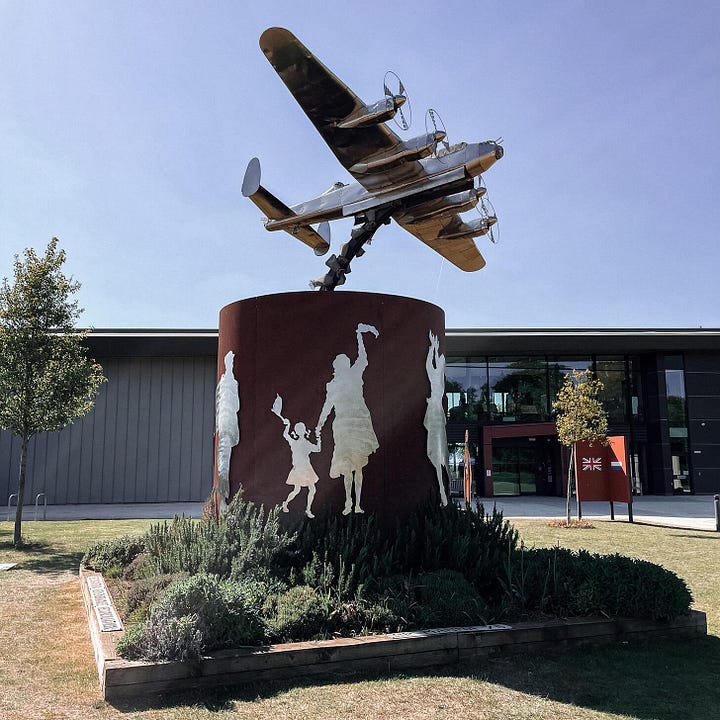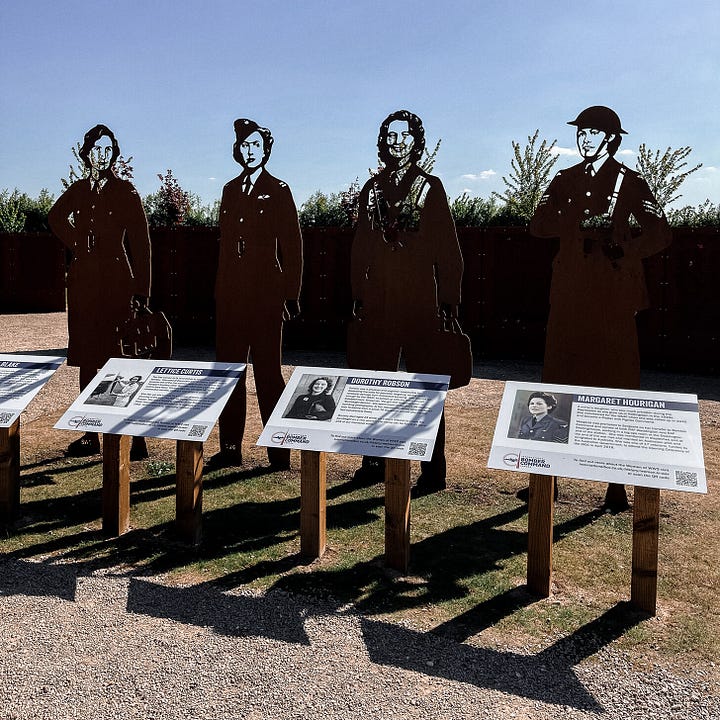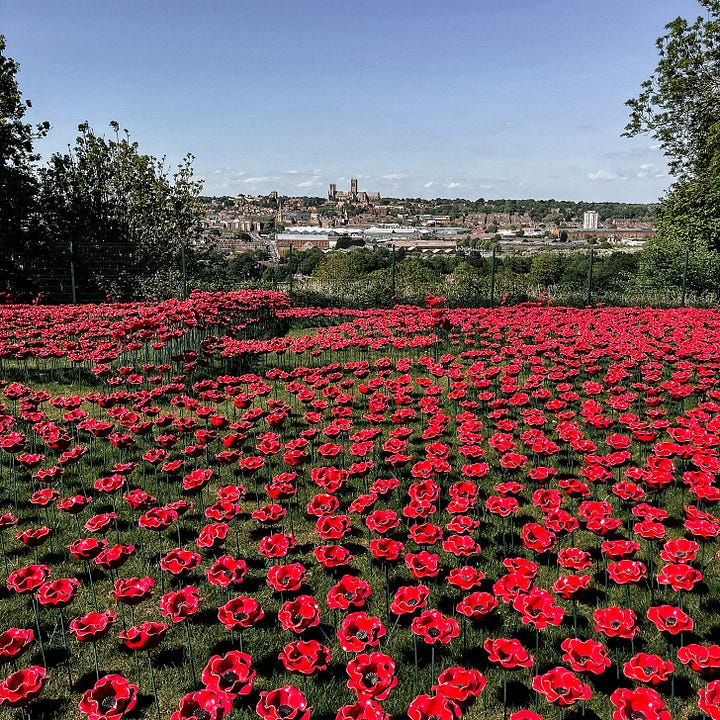Growing up in Bomber County, Lincolnshire’s aviation heritage was never far away. Since 1983, the Red Arrows have graced our skies with their aerobatic antics. In 2014, there was an unforgettable meeting of 3 Lancasters at East Kirkby, and the spirit of wartime Britain can still be found in uphill Lincoln each year as part of their 1940s Weekend.
It’s been 80 years since ‘Bomber County’ contributed significantly to the Allied war effort, and many of Lincolnshire’s airfields have long since crumbled into ruin. But, if you know where to look, proud and vibrant strands of this aviation spirit are still alive and kicking, guarding invaluable treasures which transport you back into the days when Lincolnshire’s ‘big skies’ thrummed steadily to the beat of Rolls-Royce Merlin engines.
Lincolnshire at War
You might not naturally associate wartime history with Lincolnshire, which is best known as a rural farming county—producing 20% of England's potatoes and fresh vegetables—but between 1939 and 1945, you would have been more likely to find an airman in Lincolnshire than a farmer. The demands of two World Wars populated our flat and open countryside with so many airfields that it’s estimated there was on average only 7 miles between them.
Approximately 80,000 RAF personnel made Lincolnshire their home during World War II, occupying the 49 airfields—more airfields than any other county. So it's no surprise that this volume of air traffic, combined with the close proximity to Germany, saw Lincolnshire become the centre of Britain's bombing campaigns. By the end of 1945, 720 Avro Lancaster Bombers were spread across the county, with two of the main groups of Bomber Command stationed across the airfields and 24 dedicated solely to bombing. It’s impossible to estimate how many bombing raids left these shores throughout the war, but Lincolnshire’s vast agricultural plains witnessed some of the most significant and crucial raids against Axis targets, with Operation Chastise, aka the ‘Dambusters Raid’, being one of the most famous in 1943.
Operation Chastise
Sunday, 16th May 1943. 19 bombers take to the skies over RAF Scampton, just north of Lincoln. At the helm is 24-year-old Guy Gibson, Wing Commander of a revolutionary mission to destroy 3 dams—the Möhne, Eder and Sorpe—in the heart of Germany’s industrial region. This was a daring chance to disrupt Germany’s key infrastructure and impede the German war effort.
But bombing a dam wasn’t an easy feat, requiring the engineering genius of Barnes Wallis, who developed the ‘bouncing bomb’ after skipping marbles across a bath. This modified landmine would skim across the surface of the water and harness the centrifugal force to be propelled to the very base and stick against the dam before imploding, exerting maximum destruction. Combined with another recent invention, Roy Chadwick's Avro Lancaster—an adaptable and powerful heavy bomber—the ‘bouncing bomb’ payloads brought down the Möhne shortly after midnight, the Eder following in the early hours of the morning.
The final target, the Sorpe, may have remained intact, with 53 of the 133 aircrew killed in the raid and a further 3 taken prisoner of war. But that didn't stop this feat going down in history; the engineering genius inspiring future operations and the determination and skill of the team pulling it off uplifting the Allied forces in an invaluable propagandic boost, which still has ripples today—the Dam Busters film of 1955 is considered by many as one of Britain’s greatest war films.
The Dambuster Trail
Fragments of Lincolnshire’s most famous wartime mission are still scattered across the county—remembered through their aircraft, airfields, bomber brothers and losses.
1. The Lincolnshire Aviation Heritage Centre
East Kirkby, Spilsby, PE23 4DE. Open Tuesday–Saturday, 9.30am–4pm.
The largest WWII Bomber Command airfield in the UK.
Set up by farming brothers Fred and Harold Panton as a memorial to Bomber Command, and in tribute to their eldest brother Christopher Witton Panton who was shot down on a bombing raid in 1944, The Lincolnshire Aviation Heritage Centre remains a family run museum with an exceptional collection of wartime vehicles and aircraft—including an original Barnes Wallis ‘Bouncing Bomb’. Based on the old wartime airfield of RAF East Kirkby, this is the only place in the world where you can taxi the runway in ‘Just Jane’ an Avro Lancaster Bomber MKVII—subject to bookings of course—the closest experience available to the general public to the lives of the bomber boys, the average age of which would have only been 22.
2. Battle of Britain Memorial Flight Visitor Centre
Coningsby, Dogdyke Road, LN4 4SY. Entrance by Guided Tour only.
The only airworthy Avro Lancaster bomber this side of the Atlantic—1 of 2 in the entire world.
The Battle of Britain Memorial Flight Visitor Centre is a unique place of aviation heritage, allowing visitors inside the working hangar of the operational RAF unit dedicated to preserving a fleet of WWII aircraft in tribute to the service men and women who served during one of the country's darkest hours. A Lancaster PA474, a Douglas Dakota ZA947, the oldest airworthy Spitfire in the world, alongside 4 others, 2 Hurricanes and 2 Chipmunks make up the iconic Battle of Britain assemblage—a sight unlike any other.
3. Thorpe Camp Visitor Centre
Tattershall Thorpe, Lincoln, LN4 4PL. Open every Sunday from Easter to the end of October 1-5pm.
An important heritage saved from demolition.
Formally part of the No.1 Communal Site of RAF Woodhall Spa, built in 1940, and the home of the 97, 619, 617 (Dambusters) and 627 Squadrons; Thorpe Camp was established in 1988 in commemoration of the airmen who flew from this airfield, the story of RAF Woodhall Spa and civilian life in Lincolnshire during WWII. Including the Airmen’s Dining Halls, the NAAFI, Ablution Block and Ration Store, the centre was rescued from demolition by a local group after it fell into disrepair after the war, had a stint as temporary housing and was planned to be rewilded.
4. Dambusters Memorial
Station Road, Woodhall Spa, LN10 6QL.
The ‘Dambusters’ village is in the heart of rural Lincolnshire.
From January 1944, RAF Woodhall Spa was the home of the 617 (Dambusters) Squadron until the end of the war, with much of the village commandeered as local accommodation for the airmen and ground crew. It’s a heritage this former spa town has never forgotten, erecting a memorial in the Dambusters’ name in 1987 on the site of the Royal Hydro Hotel and Water Gardens, which was destroyed during a German bombing raid. In the shape of a breached dam, this memorial is engraved with the names of all of the 617 Squadron who were lost during the war, surmounted by the poignant phrase and reminder ‘They Died For Your Freedom’.
5. Petwood Hotel
Stixwould Road, Woodhall Spa, LN10 6QG.
The idyllic retreat of the ‘Dambusters’ Squadron.
Famously commandeered as the Officers’ Mess for the 617 (Dambusters) Squadron, the Petwood Hotel was originally an idyllic country retreat built by wealthy heiress Baroness Grace Von Eckhardstein whilst she was undergoing a painful divorce. It is said that the officers particularly appreciated the Petwood as a retreat from battle, the hotel commemorating them today in the Squadron Bar, which contains a range of memorabilia and tributes to Guy Gibson VC, Leonard Cheshire VC, and their officers.
6. RAF Wickenby Memorial Museum
Wickenby, Lincoln, LN3 5AX. Open Wednesday to Sunday 10am-4pm.
The home to some of the finest squadrons of 1 Group Bomber Command.
In 1943, RAF Wickenby was a purpose-built bomber airfield home to two Lancaster Squadrons, the 12 and 626. Today, its original control tower has been preserved as a museum dedicated to the Bomber Boys who flew from here—a group who were credited with dropping more bombs and shooting down more enemy aircraft than any other station, harnessing one of the finest operational records for 1 Group Bomber Command. It’s a hidden gem of wartime Lincolnshire, sharing the intimate details of its history.
7. St John the Baptist Church
High Street, Scampton, LN1 2SE.
The most poignant trace of the war.
Servicing RAF Scampton during the war, in the graveyard of Scampton’s St John the Baptist Church are the graves of 64 Commonwealth servicemen from the air forces of Australia, Canada, New Zealand and the United Kingdom, including the Dambusters who were lost during the war, and most unusually, 9 German airmen who were shot down nearby. Normally, all German war graves in the UK were moved to the large German War Cemetery at Cannock Chase in Staffordshire during the 1960s, however, the relatives of those buried here asked for them to remain here after they saw the dedication and respect with which they were treated alongside the Commonwealth war graves. Inside the church itself, there’s also an RAF Chapel, furnished with the original squadron shields and honour boards from RAF Scampton, altar and small pews from RAF Swinderby, and chapel carpets from RAF Kirton in Lindsey. A site drenched in the honour and memory of those who served and lost during the war.
The International Bomber Command Centre
Bomber Command controlled the RAF's bombers from 1936—1968, playing a key strategic role in the bombing of Germany, and executing actions which undoubtedly shortened the war. But these missions were often daring and dangerous, with Bomber Command units suffering the highest casualty rate of any other branch of WWII—here in Lincolnshire, 25,611 RAF personnel never returned from their missions.
In 2018, after a long campaign, the International Bomber Command Centre was opened to the public, including a 31-metre tall spire, memorial walls and two peace gardens—one Lincolnshire and one international—which pay tribute to all who served and the immense sacrifice made by Bomber Command. Built on Canwick Hill, visitors experience a view of Lincoln Cathedral which would have been a lifeline to returning airmen–signalling their safe return home—and more reflectively, a view many never got to see again. It’s the largest memorial made for Bomber Command, housed in a county which knew it better than any other.
Lucie’s Visit




I must admit, this is my first time visiting the International Bomber Command Centre, which I’m slightly embarrassed about, especially as my relations served in Bomber Command during World War II. But there’s no time better than the present to rectify my wrongs, so I decided to make an afternoon of it, making the 1.5 hr trek on foot, walking through the fields of Lincoln South Common and hightailing it up Canwick Ave (an unfortunately busy road, which isn’t the most pedestrian-friendly).
Upon arrival at the IBCC, a large, modern hangar-esque building, you’re greeted by a gleaming sculpture of a Lancaster Bomber, proudly mid-flight. Naturally, my first stop was the gift shop, picking up a replica ration pack, then heading straight to the cafe (my walk was thirsty work). The cafe alone is a good enough reason to drop by, and if you’re interested in historically inspired dishes like we are, make sure you get there early enough for a ‘bomber breakfast’ (2 rashers of bacon and a scrambled or fried egg). There’s an extensive menu on offer, I ordered a jacket potato and a fresh cuppa to replenish the fuel tank.
The centre houses a ticketed exhibition (which Ellie and I plan on visiting together soon), and the spire memorial, set in a beautifully landscaped garden which is free to enjoy. I spent my afternoon strolling the gardens, reading the many names of the 58,000 men and women who lost their lives serving Bomber Command and admiring the newly installed Women in War exhibition; an installation which shares the stories of 10 women who served in different roles, making their own important contributions to the war effort.
I’m looking forward to returning with Ellie and perhaps trying a ‘bomber breakfast’.









I'd find these places fascinating Lucie. I watched a video on Colin Bell DFC Mosquito pilot extraordinaire aged 104 believe it or not worth a watch if you get a chance, one of the lucky ones! Recently one of the Conningsby Typhhons sent a shock wave through Kent on an interception, it took about 20 minutes flat out to get here! Best wushes